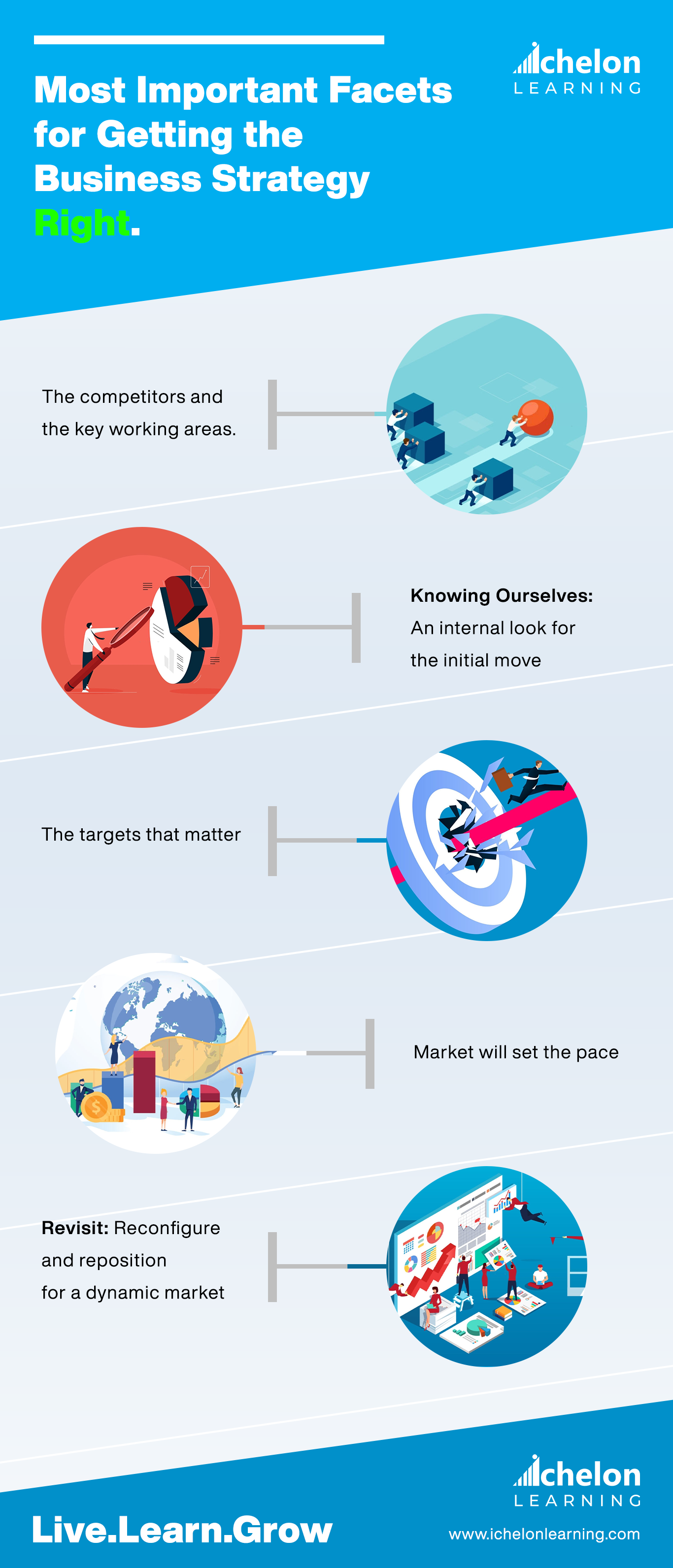While there is nothing like a “perfect business strategyâ€, the primary objective of a business is to create a sustainable business strategy and something which has the possibility to grow with scale. We would always observe businesses who find it very difficult to maintain the tempo required in the business arena. Some of them start very well and then get stuck somewhere with their business growth. Some do suffer with the “problem of plenties†and some of them do know the right ways but find it difficult to drive the show in the positive direction.
While brilliant ideas both in strategy and implementation would always make the cut, the structure and discipline in your strategy would ensure assured success for the long term. Let us discuss a few of the most important facets for getting the business strategy right.

1. From vision to goal: a path well chosen
I believe this is the most common query you would have come across in your career till now: What is your Business Vision ? Believe it or not, but it’s actually a very valid query, as everything starts with a Vision. Clarity about the vision is the most important thing to achieve, as it’s very difficult most of the time. While nobody expects you to unravel the nitty gritty of your business meaning; identifying a simple but not broad vision is important to move forward: Move forward with a Goal in mind. Further those goals need to be timelined with some key performance indicators; something to mark your progress with.
A Vision would straight forward tell you, what do you want to do and for whom and how do you expect them to value you. Do they really need you and if yes, do they already have more like you near to them or known to them. Demand brings competition and competition brings eroding margin, sometimes not a very easy situation to be in , if you are caught up there. But what a Vision helps you with: is identification of the gospel truth that you know about your business and yourself in particular; may be a drive or the special factor or the special zeal , that would definitely help you figure out the right direction, especially in troubled times.
Choosing the right path and looking for the exact milestones is very important for your journey to conclude at the right place. Even if you get lost, you may always have the right maps to drive you home safely and secured.
2. The competitors and the key working areas
Working in a world with no competition is everybody’s dream; only if our customers are empathetic to our survival needs and give opportunities to everyone to serve them. While we may have reasons to believe so, we need to be prepared for the realistic world.
I often come across business clients, colleagues and friends, who do believe that they don’t have real competitors. What I hear when they say that ; is sheer ignorance or understanding of the competitive market. If you have a market and you have no direct or indirect competitors, then you don’t have a market. While this stays as the primary fallacy, we also do identify the best in the business as our competitors while we are not working at the same scale as they are.
So, before we delve into how to identify the right competitor, we need to ask ourselves why to identify the right competitors.
Right competitors are the entities who are having a share of the same business pie which you intend to have and if you are not agile then you would end up hungry. When you pitch your offering to a prospective customer and he evaluated you and did not buy from you or hire you, it’s not that he does not need the offering now, he just preferred your competitors. If we all are competing in the same ocean, then the resources are limited and we need to strive hard and smart to survive and stay alive.
Now as we are sorted with the right competitors logic, let us delve into who is the right competitor ? A right competitor is somebody who is targeting the same business segment with more or less a similar offering or a bucket of offerings in the same business or geographic niche. As the definition is primarily limited by business segments, a clear understanding of the target segments and their buying behaviour is very important to understand anything about the competitive space. Is it the product, is it the value added service , is it the perceived value or the price, what is the driving force behind the buying decision of the target market; this is something which needs to be unravelled on one end. At the other end, what core competencies and critical success factors , these right competitors are scoring high on; this needs to be properly evaluated. A clear understanding of the above will help you in identifying all the important working areas that one needs to master to be successful in the same competitive business niche.
3. Knowing ourselves: an internal look for the initial move
Now, as we know all the smart working areas to focus on , that will help us stand tall in front of the competitors, we need to prioritize the working areas as per our current skill or quality status on the key working areas. This we achieve by activating a strong due diligence on the internal operations of our enterprise. This due diligence could be comparative evaluation around key working areas, core competency evaluation based around key working areas or as per business KPI audit. Once we know our current status on these key working areas after the above mentioned evaluations, we prioritize our working towards long term competitive advantage. These could be further established through directed working on skills and assets around products, processes or ecosystem build up. Choice of the same is made based on industry trends , current growth prospects and the resources and the capabilities power-play of the organization under consideration.
4. Market will set the pace
The need of the hour and demand for some specific utilities is mostly driven by changing consumer behaviour and consumption patterns. While there are multiple parameters which influence the market trends for any industry or specific industry product, major triggers are well defined for different industries. While political, economic and legal constructs are something one needs to take in their stride but these factors are something which not many businesses can adjust or account for significantly. The most important factors which a company should look into would be the social and the technology construct and how these are evolving over a period of time. Do we observe any specific consumer trends driven by technology adoptions or lifestyle modifications that would significantly impact our intention to buy? Do you observe any cultural and psychographic shift in the profile of the target audience over a period of time. An analysis of the historical data across regressive models along with correction of the models in line with these strong influencing trends help you draw a clear understanding of the key working areas that one should focus on. The option in hand could be new product development, new market entry, creating a more valuable ecosystem or look for collaborative growth to achieve success in all key working areas and core competencies that are needed to be mastered.
5. The targets that matter
Finally you have a realistic working area which would give you results in the next 5 to 10 years, but how would we track our strategy outcomes. The value of the journey could only be qualified by the milestones it covers and that makes it important for us to set business targets for the key working area. While targets are good, it needs to be realistic and should be bound by our abilities, opportunities and capabilities to scale up. Every working area has an associated cost centre and we need to be very realistic and a bit aggressive on our cost estimates always. While everything may look very friendly in theory, there is always a learning curve to master and it comes with its own learning cost. We keep on hearing examples of business flips; a complete change of the business model employed in the same industry or may be a complete flip of the industry altogether. Modelling all of it in your business strategy is very important and we need to value all situational cues in our revenue and cost centres. When we set targets, we generally would like to move a bit conservative in the initial years and scale business forward in line with the growth of ever evolving market. The decision to scale could be milestone driven or opportunity driven and completely depends on the risk taking appetite of the business decision makers. There are no proven formula for success here and nothing is wrong until proven so, in the real market scenario. Different business strategies have worked in the same industry and competitive space. If there is a product idea, there has to be a market for the same, you just need to plan it nicely.
6. Revisit: reconfigure and reposition for a dynamic market
Nothing is permanent in the business world and no proven formula for success makes everybody and anybody successful. While we prepare ourselves to win always, it is very important for us to be prepared for: the what ifs. What if my product fails, what if my business strategy fails, what if the industry fails? These are possibilities which nobody can ward off and a smart business needs to be prepared for it.
An agile look into the business numbers, market trends, technological advancements and demand for a new ecosystem will always keep you one step ahead of your competitors. If something does not look that progressive , we need to pre-empt the possibilities and be ready to adjust for the same. Future is something which is not far off as it’s relatively moving towards you, as you are moving towards it. An adjustment in the business or product strategy needed to cater to ever demanding consumer is the biggest skill that you need to have. Your consumers will change and you would have new prospective consumers whom you have never considered a valid target audience. There are multiple examples of the same across businesses and industries.
To have sustainable and long lasting success, you need to have a sustainable core proposition which remains evergreen for its customers, along with an ever evolving business and product strategy: if you are not dynamic, you are anyhow dead.



